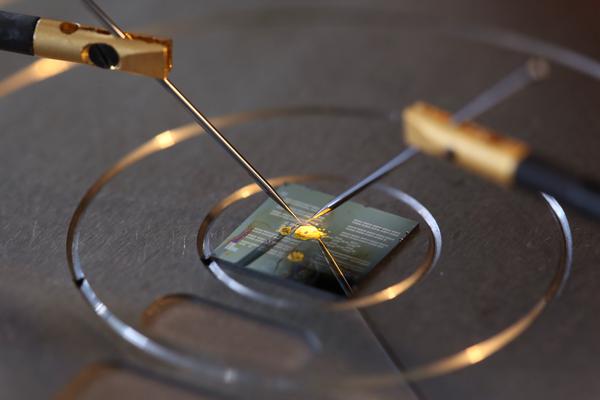Building the ultimate light detector

Eric Bonvin in the CMI clean room ©Alain Herzog/EPFL
Summer Series on Student Projects: Cutting-edge materials like graphene and perovskites can become ultra-sensitive photodetectors.
Eric Bonvin is currently working at László Forró’s lab at EPFL. A Swiss-American, he was born in the Lausanne area, and grew up in Switzerland. His summer project aims to develop ultra-sensitive light detectors that can theoretically pick up a single photon. To do this, Bonvin is given the difficult task of combining two of the most exciting materials: Graphene and perovskite.
Graphene is the stuff of science fiction: the strongest material known, it also has exceptional – if not exotic – electrical properties, and possibly even beyond that. As for perovskites, their ability to convert light into electrical current has firmly placed them among the best materials for efficient solar panels.
After graduating from a Swiss high school, Bonvin began studying physics at EPFL. He spent the first two years of the bachelor’s degree there, the third year on an exchange program that took him to Carnegie Mellon University in Pittsburgh.
Returning to EPFL for his Master in Physics Engineering, he carried out a first-year project on graphene in László Forró’s Laboratory of Physics of Complex Matter. Having finished his masters, he will continue in the lab over the summer to pursue the project in depth.
“My project is all about creating photodetectors for use in low-light conditions,” he says. “I am combining graphene and perovskite – two materials that have sparked the interest of researchers in the past decade – in order to create devices that are ten million times more sensitive to light than regular silicon photodetectors – the standard technology used today.” In theory, the efficiency of such materials is high enough to detect a single photon – “even at room temperature”, says Endre Horvath, who leads the project Eric works on.
 To create such sensitive systems, Bonvin first developed a method to grow perovskite from a solution into thin nanowires directly on top of graphene sheets. This step is crucial, as the light sensitivity of the devices depends on the way the nanowires are structured; the architecture is the key to optimal photodetection.
To create such sensitive systems, Bonvin first developed a method to grow perovskite from a solution into thin nanowires directly on top of graphene sheets. This step is crucial, as the light sensitivity of the devices depends on the way the nanowires are structured; the architecture is the key to optimal photodetection.
Nonetheless, doing this is a challenge. In developing his own method, Bonvin drew from the lab’s expertise in microfabrication of nanowires. The process involved high-precision machines and a lot of trial-and-error, but in the end, Bonvin saw his graphene-perovskite nanowires growing in beautiful straight lines. “The growth method is controllable, reproducible, cheap and scalable,” he says excitedly. “It is ideal for large-scale processing.”
The devices themselves are microfabricated at the clean room of EPFL’s Centre of MicroNanoTechnology. The reason for microfabricating them is to improve the efficiency of the device, as smaller devices are less likely to contain impurities, and can therefore achieve higher efficiencies. Microfabrication also allows the devices to be engineered in a way that actually include very few nanowires. This also reduces the likelihood of impurities, leading to higher efficiencies.
Such ultra-sensitive photodetectors have multiple applications. These include night-vision systems, CT scanners, detectors used in particle accelerator experiments and even light-based quantum computing systems, which require detection of single photons. “I think our detectors can actually achieve that,” says Bonvin.
Even more exotically, the detectors can be used in space telescopes, which detect weak signals from distant galaxies across the entire electromagnetic spectrum. “Our detectors respond to a very large part of the spectrum, from near-infrared all the way to X-rays. This means that we would only need one detector to do a job that requires multiple detectors today.”
Bonvin’s project offers a method of developing ultra-sensitive detectors by combining two materials that are cheap to manufacture. “In the future, I would like to see further development of these sorts of photodetectors – and possibly see the first applications of them appear.”
Bonvin is currently looking searching for a PhD position in the area of solid-state physics. But this summer project has already set him on a professional course. “Throughout the project, I learned a lot about photodetectors, graphene and perovskites. Next I would like to go even further and design new devices that work with the same underlying principles but with an optimized architecture. I have acquired many microfabrication skills that I will be able to apply in all sorts of projects in the future.”



